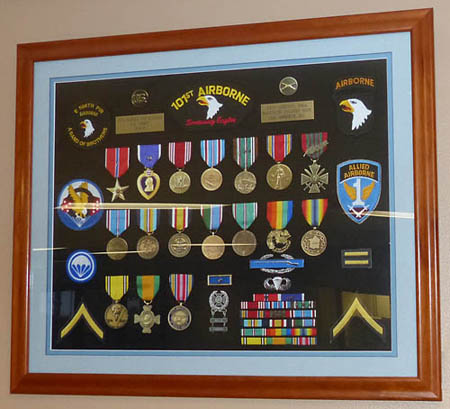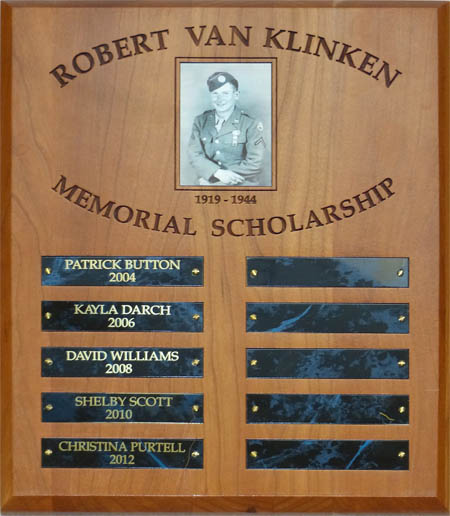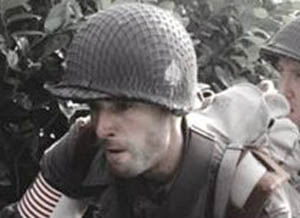| |
Small Plaque, Big Story
Robert Van Klinken
by Geof Childs
 Robert Van Klinken's medals and stripes hang quietly above the trophy case at Liberty Bell High School. Photo by Sheela McLean In the south corridor of Liberty Bell High School, just to the right of the doors leading into the gymnasium and above the trophy case, is a small wooden shadow box containing the military decorations awarded to Robert Van Klinken. He was a Twisp resident who, between 1942 and 1944, served with Easy Company, 2nd Battalion, 506th Parachute Infantry Regiment of the 101st Airborne Division.
A gift to the school from Charles T. Borg, the medals represent an extraordinary tale of war and duty and remembrance. They also represent a college scholarship awarded every other year to deserving seniors.
Yet despite a genealogy that includes at least one famous author, an Emmy award-winning television series, more military heroes than you can count, Hollywood luminaries such as Tom Hanks and Steven Spielberg, and a plot line that ranges from continent to continent and one end of the valley to the other the Van Klinken story remains little known and much deserving of local attention.
 Every other year a scholarship is awarded in Van Klinken's name. Photo by Sheela McLean Robert Van Klinken
Born on October 31, 1919, in Loomis, Washington, Robert was the eldest son of Walter and Cora Van Klinken, a second-generation Dutch couple who moved their young family from Kitsap to Okanogan County in the early part of the last century in pursuit of job opportunities and a lifestyle more fitting their quiet manner. Arriving in Pateros and then moving to a homestead in the Methow the Van Klinkens lived modest, hard-working lives. It is easy to imagine the pride they must have felt when Robert became the first member of their family to graduate from high school.
With job opportunities in those Depression years somewhat limited, Robert spent two years working in the local mines before finally finding a job as an auto mechanic in Twisp. That didn’t last long: in the late autumn of 1941, and just three weeks before the Japanese bombed Pearl Harbor, he was drafted into the military.
When Robert reported for basic training at Fort Lewis, he decided to volunteer for the airborne infantry. In early 1942 he found himself stationed at Camp Toccoa, GA where, despite being listed as “nearly blind in his left eye”, he completed basic parachute training at the top of his class. Outgoing and athletic, he soon found himself assigned to Easy Company in the newly formed and 506th Parachute Infantry Regiment (PIR). Wildly excited at finding himself a member of what he described as the “best and toughest outfit in the army” Robert next received training in both the bazooka and demolitions before spending 31 days in the hospital because he hit a tree during a practice jump.
Robert was listed as “unfit for duty” and faced the prospect of either being washed out of his unit or discharged from the military altogether. Nonetheless, Robert’s letters home to his beloved sister Susie never faltered in maintaining an upbeat tone and expressing his continuing desire to pursue the “adventure of a life time.” While it is unclear exactly when his status changed it is known that in August, after several weeks without hearing from him, Susie received a short letter asking how she and her husband, Johnny, were enjoying life in Holden and mentioning, almost as an aside, that he was on a boat headed for the war in Europe.
 Robert Van Klinken was first listed as "unfit for duty" but then became part of Easy Company. Photo from Wikipedia Arriving late that fall in Aldbourne, England, Easy Company trained continuously throughout the winter and in the late spring moved to the airbase at Upottery to prepare for the invasion of Europe. Early on the morning of June 6, 1944, under the leadership of their much-admired commanding officer, Richard Winters, Robert’s platoon loaded onto a C-47 and headed south.
Owing to censorship, and his desire not to alarm his family, Robert’s letters home refer to D-Day only as “that jump in France” and little specific detail exists as to his actual activities during those first few days of fighting. When interviewed some four decades later, LT. Winters did, in fact, remember that Robert was on his plane for the jump and it is reasonable to assume that he would have participated in both the assault on Brecourt Manor and, a few days later, the “vicious battle” to capture the French town of Carenton. What is know for certain is that sometime towards the end of that first week of combat Robert was wounded by shrapnel and evacuated to England for medical care.
Writing to Susie from his hospital bed his letters retain their cheerful, uncomplaining tone, brushing off a recent ‘Dear John’ letter (“. . . there will be lots of girls left when I get back”) and confidently looking forward to a rematch with the much vaunted German Wermacht (“The Jerry’s aren’t as tough as I figured . . . they sure can’t stop the paratroopers”). In a final letter post-marked September 7, 1944, he speaks both with satisfaction about rejoining Easy Company, which had just returned to England after 33 days of continuous combat in France, and with eagerness in regard to getting on with the war. His letter closes with just two simple words: “So long.”
Ten days later the 506th jumped into Holland as part of Operation Market Garden. The brainchild of generals Montgomery and Eisenhower, the goal of Market Garden was to inject 36,400 American, British and Polish soldiers into the Dutch countryside where they would make an end run around the German defensive perimeter known as the Siegfried Line and drive southeast across Europe to link up with the allied forces fighting their way out of France. Meeting only sparse initial resistance the members of Easy Company found themselves greeted as heroes and liberators as they marched into the city of Eindehoven which, up until only a few days earlier, had been occupied by the Germans. Amidst that atmosphere of celebration one can only imagine the local’s additional astonishment when, having approached Robert and his two best friends—Donald Hoobler and David Kenyon Webster—to inform them that a small group of Nazis were hiding in a local factory Robert, who had grown up in a Dutch-speaking household, responded to them in their own regional dialect: “Wacht more eevns. Wie hoain heur der wel oet” (“Hold on, we’ll go get them out”).
 In the movie "Band of Brothers", Van Klinken was portrayed by actor Ezra Godden. Photo from Wikipedia Easy Company had been ordered to begin clearing the countryside south and east of Eindehoven. They were reconnoitering the small town of Nuenen when on September 20, 1944, they came under attack by a substantially larger force of German infantry and tanks. During the fighting that followed Robert was moving forward with his bazooka when he was hit by machine gun fire and evacuated to the rear where he died later that evening. As was standard procedure in those days, his mother, who was still mourning the recent death of her husband, received only a short, tersely worded telegram expressing the nation’s regrets that her son had died in combat.
Over the next few weeks as news of the allied retreat from Holland filled the papers, Cora received several additional telegrams, each providing more details concerning the circumstances of Robert’s death, until on December 27, 1944, a final missive came from the Secretary of War in which he extended his hope “that time and the victory of our cause will finally lighten the burden of your grief.” It didn’t. Robert’s remains were eventually interred at a military graveyard in the Netherlands and Cora spent the rest of her life grieving the “hardworking, adventurous country boy” she had sent off to war.
Robert’s loss was a hard blow to the tight-knit community of the Methow. Charles T. Borg, a six-year-old living across the street from the Van Klinkens, remembers vividly how his father had come home early from work one afternoon and mentioned that something “very sad” had happened to the neighbors. But, as humans, we are divided by both our need to remember and our desire to forget, and in time the war ended, the soldiers came home and Robert Van Klinken slid quietly into the past.
Charles T. Borg
It is probably fair to say that Chuck Borg had all but forgotten his ill-fated neighbor when, in the early 1960’s he, too, entered the military and found himself assigned to an infantry division in Europe. The World War had been over for more than a decade and a half by then and few outward signs of the conflict remained other than occasional monuments and, of course, the vast graveyards in which thousands of young Americans lay buried in Flanders Fields. In late fall of 1962 Chuck and a small group of colleagues who were participating in an officer exchange program with the Belgian Army decided to visit the American military cemetery at Margraten in the Netherlands. Their trip, however, got off to a slow start and it was not until late on a dreary Sunday afternoon that they actually arrived at the graveyard.
Finding himself in the midst of over 8,300 American military war dead Chuck was struggling to grasp the scale of sacrifice surrounding him when he looked at his watch and realized he would have time to make only a single pass up and down the center aisle before returning to his friends. Reading as many inscriptions as his rapid pace would allow he had just reached the end of the aisle and was turning to leave when, out of respect for the setting, he stopped, looked back at the white cross closest to him, and read the name: Robert Van Klinken.
During the years that followed whenever the subject of coincidence or serendipity would come up in a conversation Chuck would immediately think back to that moment at Margraten. But life was busy and he was fully engaged in a military career that would take him twice to Vietnam as an infantry field officer and, eventually, to the Pentagon where he finally retired before moving to Alaska and serving first as deputy commissioner of Military and Veteran’s Affairs and, finally, as director of the Alaska Federal Health Care Partnership. And it is likely that the Robert Van Klinken story would have again faded almost entirely from his memory had Chuck not picked up a copy of Steven Ambrose’s “Band of Brothers” in 1999 and there on page 138 found Robert’s name. A year later he saw it again, this time scrolling across his TV screen as he was watching an episode of the Tom Hanks/Steven Spielberg produced mini-series of the same name. Thus provoked, Chuck decided that it was, at last, time to take action.
His first call was to the town offices in Twisp where he was put in touch with Robert’s niece, Cora Bingamann (Susie’s daughter), who helped him in pulling out some of the details of Robert’s service from his letters home. His next contact was with Richard Winters, the principle character around whom the “Band of Brothers” series revolved, who told him that Robert was, indeed, well remembered and much regarded by his former comrades. With those cornerstones in place, Chuck along with his wife, Nancy,and his sister, Barbara, spent the next two years assembling a chronology of Robert’s military service which eventually took the form of a shadow box containing all his military decorations which, in 2003, Chuck presented to Cora.
Next, working with the Methow Valley Education Foundation, they established a a scholarship to honor Robert’s service. It is awarded every other year to a graduating Liberty Bell senior whose efforts and ambitions are deemed “deserving of recognition.” Yet, in the end, what I think might be most representative of Robert Van Klinken is that the scholarship cannot be applied for. It is just there, looming in the background, quietly awaiting our notice and in the process imprinting itself not only upon the best of what we have been but on the best of what we can hope to be as a community.
1/10/2014
see past stories in the archive >>
|
|
